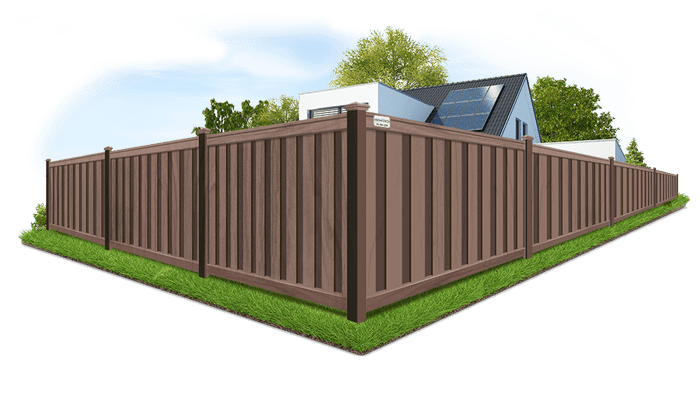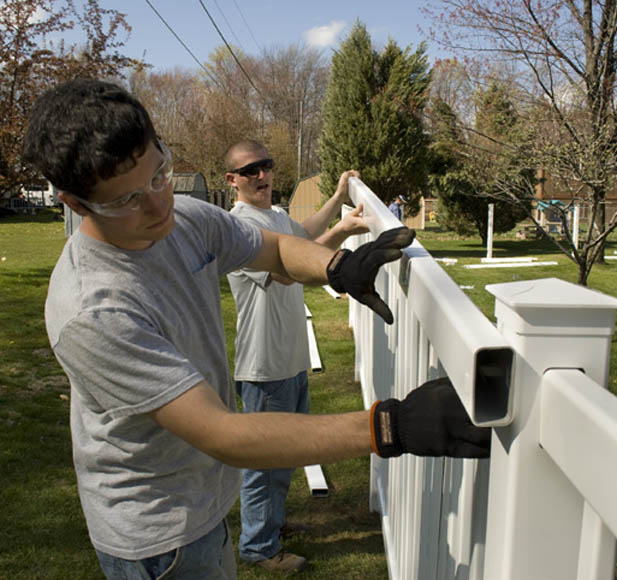How to Recognize Usual Concerns That Require Immediate Fence Repair Service
When it involves preserving your fencing, it is important to detect problems prior to they come to be bigger issues. Frequently looking for signs of decaying wood, leaning panels, or rust can save you money and time in the future. You could not understand just how weather and insects can jeopardize your fence's stability. Allow's discover the common indications that show your fencing needs instant interest, so you can keep your residential or commercial property safe and looking its ideal.
Indicators of Rotting Timber in Wooden Fences
Have you seen your wood fencing looking a little bit shabby? If so, it could be time to look for signs of deteriorating timber. First, analyze the base of the articles and panels for soft places. If you press on the wood and it really feels mushy or collapses, that's a clear indication of rot. Next off, look for staining or dark areas on the wood-- these frequently signal moisture damages. Take notice of any type of peeling paint or coating, as this can subject the wood to more degeneration. Furthermore, a poignant, stuffy odor can indicate fungal growth. Do not forget to check joints and connections; if they hang or dropping apart, the wood beneath is likely compromised. By catching these indicators early, you can stop a lot more substantial damages and maintain your fence standing strong. Routine maintenance is essential to prolonging the life of your wooden fencing.
Leaning or Tilting Fencing Panels
It's critical to recognize what triggered it if you've seen your fencing panels tilting or leaning. This problem might suggest underlying architectural damage that requires your focus. Allow's discover the usual causes and the repair work options available to obtain your fencing back in shape.

Reasons of Leaning Panels
It's usually an indication of underlying concerns that need dealing with when you see your fencing panels turning or leaning. One common cause is insufficient water drainage; excessive water can wear down the dirt around the fencing posts, damaging their support. An additional culprit might be solid winds or storms that push against the panels, specifically if they're not properly secured. In addition, the all-natural settling of dirt with time can cause posts to shift, causing a tilt. Parasites, like termites, can jeopardize the integrity of wooden panels, causing them to lean as well. Bad setup techniques may result in panels not being securely set, leaving them vulnerable to leaning under pressure. Address these issues without delay to keep your fencing's stability.
Indicators of Architectural Damage
Noticing leaning or tilting fencing panels can be disconcerting, as these concerns commonly show architectural damage that requires instant focus. When your fence begins to lean, it might indicate that the messages are shifting or that the soil around them has actually deteriorated. Pay very close attention to spaces between articles or panels, as these can additionally suggest instability. deck builder. Furthermore, check for splits or splintering in the timber, which can damage the total framework. If you observe rust or corrosion on steel elements, it might compromise the integrity of the fencing. Bear in mind, neglecting these indicators can result in a lot more extreme damage down the line, so it's vital to assess the scenario quickly and do something about it prior to it intensifies
Repair Options Available

Corrosion and Corrosion in Metal Fences
If you possess a steel fence, you may see rust and rust creeping in with time, particularly if it's revealed to dampness. These issues not only influence the look of your fence but can likewise endanger its structural stability. To identify rust, search for reddish-brown places or patches, which suggest the steel is oxidizing. Deterioration can spread out rapidly if left untreated, weakening the fence and leading to pricey repairs.To tackle rust and corrosion, you need to cleanse the influenced areas with a cord brush and apply a rust-inhibiting guide. When the primer dries out, take into consideration painting the fence with a weather-resistant paint to safeguard it additionally. Regular maintenance, such as examining for indications of corrosion and repairing paint as needed, will help prolong your fencing's life-span. Resolving these issues promptly guarantees your metal fence remains strong and visually appealing for many years ahead.
Cracks and Divides in Plastic Secure Fencing

Root Causes Of Plastic Damage
Plastic fence is prominent for its sturdiness, yet it can still deal with splits and divides as a result of numerous variables. One major cause is extreme temperature fluctuations. It can compromise the material over time when plastic increases in the warmth and agreements in the chilly. In addition, exposure to severe sunlight can cause UV deterioration, making the plastic weak. Physical influences, like hefty branches or unexpected accidents, can additionally produce fractures. Poor setup or using low-grade materials can exacerbate these concerns. In addition, age contributes; older plastic fence is much more susceptible to damages. Routine evaluations can help you identify these factors prior to they bring about considerable problems. Take proactive actions to assure your fencing remains strong and undamaged.
Repairing Cracks Successfully
Although fractures and splits in your plastic secure fencing can be worrying, resolving them quickly can avoid additional damages and preserve the fencing's look. Analyze the size of the fracture. For tiny cracks, a vinyl repair package typically consists of adhesive that can bond the sides, providing a seamless fix. Clean the location thoroughly prior to using the glue, ensuring it adheres correctly. For bigger divides, you might need to utilize a plastic spot. Cut the spot to size, apply glue around the sides, and press it firmly onto the split. Permit it to cure based on the maker's instructions. Routine upkeep and quick repairs can prolong your fence's life-span, maintaining it looking excellent for several years ahead.
Loose or Missing Out On Fence Articles
Loosened or missing fencing blog posts can threaten the security of your whole fence framework. It's vital to deal with the problem right away if you discover any kind of posts wobbling or leaning. Examine for any signs of movement, as this can lead to more damages gradually. You can easily evaluate the issue by providing each blog post a gentle shake-- if it feels unsteady, it's time to take action.For missing out on messages, you'll require to replace them immediately to keep your fencing's stability. When you set up new posts, make sure they're securely secured in the ground with concrete or crushed rock for added stability. If a post hangs, tighten it by adding additional assistance or driving it deeper into the ground.Ignoring these concerns can lead to larger problems, like spaces in your fencing or even total collapse. Keep an eye on your messages and stay proactive regarding fixings!
Damages From Climate and Natural Elements
Weather and natural environments can inflict havoc on your fence, bring about different kinds of damages that require punctual interest. Heavy rainfall can create wood to rot, making it weak and unstable. Snow build-up may flex or damage panels, while strong winds can root out fencing messages or create areas to lean.If you discover splits or splintering in wooden fences, it signifies drying out because of intense sunlight exposure. On the other hand, metal fences can corrosion if protective coverings disappear, especially in moist or coastal areas.Inspect your fence routinely after tornados or severe weather to capture any kind of damage early. Dealing with these concerns promptly can conserve you from expensive fixings down the line. Don't wait until a tiny trouble becomes a significant one; stay proactive and keep your fence top shape to preserve both performance and visual appeal.
Insect Invasion and Termite Damages
It's essential to act swiftly to avoid additional damage when you notice indications of bug infestation or termite damages. Seek mud tubes along your fence or hollow-sounding wood, as these suggest termites are at work. You could additionally see tiny holes or frass, which is termite droppings looking like sawdust. If you find any of these indicators, it's time to examine the damage.Don' t delay till it's far too late; insects can compromise your fencing's stability. Evaluate the surrounding area for ants or beetles, as they may be adding to the issue. If you presume an invasion, consider calling an insect control specialist to validate and deal with the issue.Repairing or replacing damaged sections of your fence immediately not only recovers its strength but additionally stops bugs from spreading out further. Stay attentive to keep your residential property pest-free and protected.
Frequently Asked Inquiries
How Usually Should I Examine My Fencing for Damages?
You must inspect your fence at the very least twice a year, preferably throughout spring and autumn. Regular checks aid you detect damage early, saving you money and time on repairs while preserving your residential or commercial property's look and security.
Can I Fix a Fencing Myself or Hire an Expert?
If you have the right tools and abilities, you can absolutely repair a fence yourself. However, hiring a specialist assurances high quality job and conserves you time, especially for intricate fixings or comprehensive damages.
What Devices Are Required for Fundamental Fencing Fixings?
For fundamental fencing repairs, you'll require devices like a hammer, screwdriver, pliers, a saw, a level, and measuring tape. deck builder. Relying on the repair service, fence contractor owensboro ky you might additionally call for nails, screws, or substitute boards
Just How Much Does Fencing Fixing Commonly Expense?
Fence repair prices differ extensively, yet you can anticipate to pay between $200 and $1,500 depending upon materials, labor, and extent of damage. It's smart to obtain numerous quotes for the very best deal.
When Is the Best Time of Year for Fencing Fixes?
The very best time for fencing fixings is throughout mild climate, usually in spring or early autumn. You'll prevent extreme temperature levels, making it much easier to function and making sure the products set properly for lasting longevity (deck builder). Discovering turning or leaning fence panels can be disconcerting, as these concerns frequently indicate architectural damage that needs instant attention. Loose or absent fence messages can weaken the stability of your whole fencing framework. Snow buildup could bend or damage panels, while strong winds can root out fence posts or create sections to lean.If you discover fractures or splintering in wood fencings, it's an indicator of drying out due to intense sun direct exposure. Metal fencings can rust if protective coverings put on off, especially in moist or coastal areas.Inspect your fence frequently after tornados or extreme weather to catch any damages early. Fence repair work prices differ commonly, however you can expect to pay in between $200 and $1,500 depending on products, labor, and degree of damage